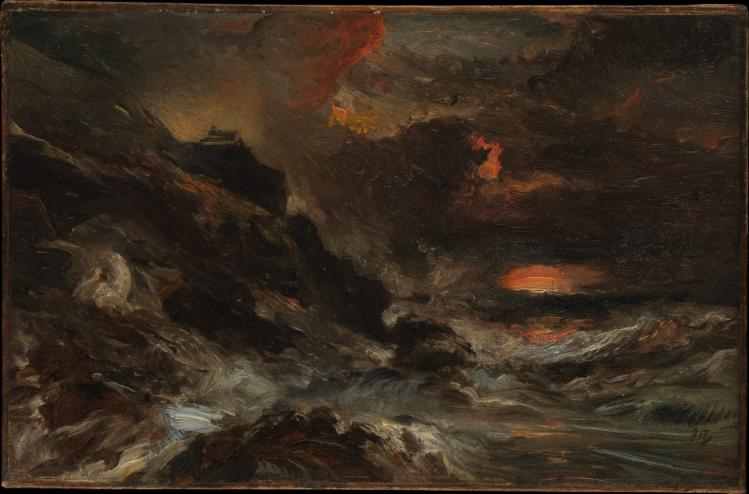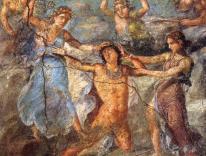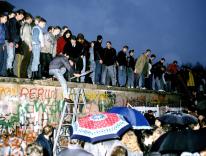
In today’s stories about weather, humans are the villains. At least, that’s how it feels. When reservoirs run dry, when a wildfire burns, when a “historic” flash flood or freeze arrives—we feel responsible, even ashamed. Climate change. We shake our heads. This is what we get for driving cars and eating meat, for being unable or unwilling to reduce emissions. In reality, of course, it’s impossible to determine global warming’s precise impact on every hurricane or tornado, much less our individual responsibility for these catastrophes. We’re not just perpetrators, but victims, too: evacuating, rationing fuel and food, and shivering in our apartments. Still, we’re pitiful in the way of a crook who’s had his comeuppance, suffering, at least to some degree, because of our own hubris.
George R. Stewart’s novel Storm doesn’t think about weather this way at all. Written in 1941, and recently re-released by New York Review Books, the novel takes place before any code red for humanity has sounded. People aren’t responsible for the severity of Maria, a storm that washes over the novel’s drought-stricken California. She brings rain and snow. She causes a fair degree of damage, plus sixteen deaths—but not because of anything we humans did.
Indeed, one of Stewart’s grand theories of nature is that it’s indifferent to us. He writes scornfully of the “high-priests and shamans and medicine-men” who “beat drums for rain, and cried that the gods were wroth.” Though eventually more scientific minds prevailed (Plato, Galileo), and man “no longer babbles a charm, or tears his flesh in supplication to a storm-demon,” he has not yet attained “that dream of Magaian, witch, and druid—not to predict weather, but to control it.”
Each of Storm’s twelve chapters, representing a day in the life of Maria, begins with this kind of discourse from Stewart—a heady proclamation about history and geologic time and the futility of human endeavors. “Air is so bound up with a man’s life that only with difficulty can he realize its existence as something in itself,” he writes. Perhaps we owe our durability as a species to weather: “With each storm and passing front, blood pressure rises and falls, nerves react, secretions alter.” Stewart, who was a historian and professor of English at UC Berkeley, proposes theories about ancient civilizations and faiths. He questions free will and progress. He imagines the end times, when man will have “run his course and vanished” with “sky-towering crags reduced to gnawed stumps of granite” and a “stormless climate” covering the earth. He quotes from Hamlet. He quotes King David. He has little sympathy for the storm’s victims, reminding us that “the sixteen died not because of the storm, but because of their own mortality...after a few years they would in any case have died.”
You could read all this grandiosity as irritating or entertaining. Either way, it’s part of the book’s intention to take weather seriously, not just a physical reality, but as essential to religion, culture, and the endurance of our species. This concern with survival and extinction appears throughout Stewart’s work. From his post-apocalyptic novel, Earth Abides, to his historical study of the Donner Party, to a volume of speculative anthropology, he wonders where we came from and where we’ll end up. His hunch is prescient: our environment will determine our fate.
Each of Storm’s chapters precedes in brief, numbered sections, moving between different landscapes and characters. Some passages describe the storm’s physical impacts on thirsty fields, a glimmering city, a rotting stump, and animals, including a boar and a coyote. Others feature catalogues of trees, peaks, lighthouses, and summits. (Stewart, a toponymist, is also known for his academic volume of place names, Names on the Land.)
Stewart does his best to make Maria herself a character, namely through the imaginings of a Junior Meteorologist (the J.M.) who first spots her forming over the ocean. The J.M. observes Maria with “fatherly feeling” over the course of her life, watching her grow from an “incipient little whorl” with a fate as unknown as a “human child, born the same hour,” to a crotchety-middle aged person, to a mother, spinning off another storm, until finally watching her death. He feels “sentimental” about it all, though as Stewart points out elsewhere, thinking of weather as your daughter is a fallacy: “Great storms know neither love nor hate.” But the long passages about Maria that are purely scientific—all pressure readings and moisture content and cold fronts—are dull, even skippable. Turns out, a reader needs some anthropomorphizing—a name, and a relationship to a sympathetic meteorologist—to make the storm worth watching.
Thank goodness the novel has other characters to contend with. The storm “vitally affected, in one way or another, the life of every human being in the region,” and the book is at its strongest when it describes those effects. Stewart was a master of microhistory; his book Pickett’s Charge examines the final attack at Gettysburg as a way of studying the entire Civil War. In Storm, too, he takes a detailed look at individuals in order to study a larger entity. We follow some people throughout the book: an electric lineman who has fallen in love at a dance; an elderly meteorologist who longs to be taken seriously; a waitress who takes an ill-fated road trip with her boyfriend. Other people and places appear only once. The congregation of a country church prays for rain just before the storm breaks. A Berkeley literature professor writes a poem about seagulls on a campus lawn who’ve flown in from the turbulent coast. A fur trader fills up his tea kettle and hunkers down against bitter winds. The novel is scientifically structured as a chain of causes and effects, its stories both linked and fated. Characters are in the right or wrong place at the right or wrong time. Best-laid plans go astray. The impacts we celebrate—“the saving of a crop in California,” for instance—might lead to “foreclosures in Oklahoma, suicides in Florida, strikes in Massachusetts, and executions in Turkey,” for all we know.
And yet, the novel is also a testimony to human ingenuity and invention, an ode to a series of men named only by their occupations. The J.M. uses colored pencils and mathematical equations to calculate storm trajectories on a map. The Superintendent directs snowplows, desperate to keep the Donner Pass open. The General decides when to open the floodgates. Various men dispatch planes and trains; they write news reports and reroute telephone connections. Some die of cold, or of a “drenching.” They rise early and stay up late. They drink strong cups of coffee, eat steaks and boiled potatoes. They do whatever it takes to get their jobs done. At its core, Storm is dedicated to public utilities and the fellows who maintain them. Stewart acknowledges a whole list of bureaus—the California Divisions of Highways, PG&E, Western Pacific—that offered “generous assistance” during the writing process.
Meanwhile, the rest of us are bumbling. We try to drive on a mountain road without chains. We grumble about momentarily dropped business calls, not knowing the work that’s happening behind the scenes to repair the connection. A sixteen-year-old (“Dirty Ed”) shoots out a switch box with a pellet gun on a dare, which later causes a tunnel to flood. Foolish college kids speed through the rising water, stalling out their engine. They light some cigarettes and wait to see what will happen. It takes capable professional people (the police, a truck driver) to fix the situation. It’s not unlike today, as we buy goods wrapped in plastic and draw energy from fossil fuels, waiting for scientists and politicians to come up with solutions. With Maria, at least, there’s an end. The storm breaks up, the roads get repaired, the crops blossom, the deaths are mourned. The globe gives “no sign that storms or men disturbed its tranquil round,” hanging “unflickering and serene.”
If man could “master the laws of the air,” then “will he at last have to stop talking and speculating about the weather?” Stewart wonders. And will the “removal of the daily mystery only serve perhaps to make life safer and more boring?” Safe and boring: two adjectives we likely all wish were more applicable to weather. Stewart didn’t need to worry—we certainly haven’t mastered anything, even with computer modeling systems and more advanced radar. It’s still true that “man is of the air, and the air must rule him.” It’s truer than even Stewart could have imagined.
Storm
George R. Stewart
New York Review Books
$17.95 | 304 pp.
Please email comments to [email protected] and join the conversation on our Facebook page.
Previous Story
Benjamin’s Warning
Next Story
‘Steadier Than Before’


